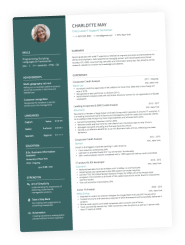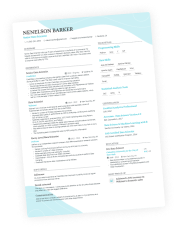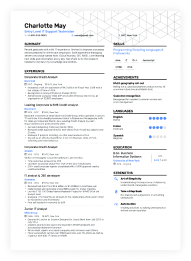If you’ve spent any time reading up on CVs, you’ve almost surely come across the term ‘reverse chronological order’. It’s the standard CV format across the board.
But does it still stand up, and should you use it? Short answer: Probably, yes.
But there’s much more to consider. Absentmindedly leaning on this old standard could let you down, and it might not give you a leg up on your competition like alternative CV formats sometimes can.
In this article, we:
- Explain what reverse chronological order (RCO) is.
- Cover the pros and cons of the RCO format.
- Describe the two most common alternate CV formats.
- Help you understand when to use each.
- And share our best quick tips for formatting a winning RCO CV.
What is reverse chronological order, and why is it used?
Reverse chronological order (RCO) is when you format your CV to list your experiences by moving from the most recent to the oldest. For example:
- January 2021 - Present: Senior Software Engineer, Tech Innovations Ltd., London
- May 2018 - January 2021: Software Developer, Digital Solutions Inc., Manchester
- September 2016 - April 2018: Junior Software Engineer, InnovateTech Ltd., Birmingham
A well-formatted CV is crucial for a successful job search. A recruiter won't spend extra time on you if you make their job difficult from the start, so good formatting is a top priority.
The order in which you’ll present your work, education, and other experiences is an important part of your overall CV formatting considerations. So you must give it some thought.
While it’s standard to use RCO, there are alternatives you can use depending on career progression, gaps, or changes in your career. Alternative formats, like functional or combination CVs, prioritize skills or achievements and can gloss over gaps or highlight transferable skills.
Reverse chronological order: Pros and cons
There are two sides to every story. It may be cliched, but this platitude holds for reverse chronological order as much as it does anything else you come up against.
Consider both sides to take control of the career history you tell on your CV:
Pros
Serves the best up first
RCO presents recruiters with your most recent experience first, so they’re not likely to miss it. This is great since your current skills, most recent experiences, and achievements are usually the most relevant to the positions you're applying for.
Paints a picture
The reverse format also helps recruiters follow your career progression bypresenting your work history clearly and chronologically. They can easily track your career trajectory, noting promotions, job transitions, and skill development over time, giving them a great window into your career journey.
Little to worry about
Reverse chronological format is familiar to recruiters. It’s the standard and meets expectations across industries and countries.
By sticking with the conventional approach, you’ll show recruiters you meet some of their basic expectations of professionalism and that you won’t come across as too edgy.
Cons
False alarms
The emphasis that reverse chronological order places on listing your experiences in order can highlight gaps in your work history or changes in your career direction.
Recruiters are always looking for red flags. These gaps or changes could raise questions about your consistency and reliability at work.
Can leave things in a jumble
The flip side of highlighting recent experience is that past ones can get lost in the mix. The likelihood a recruiter misses something increases the further back it is in your history.
Of course, this can be a problem if you're applying for a job for which you have relevant skills, but they happen to be from a job you held some time ago.
Not one size fits all
Presenting your experience in a non-linear format is preferable in some industries or situations, such as if you’ve had a diverse career path or are entering a new industry. In that case, the standard RCO format limits how you can present transferable skills or qualifications.
Alternative CV formats can prioritize skills or achievements over strict chronological order. They’re great if you’ve been out of the workforce for a while or are changing fields.
Also, you may benefit from an unconventional format if you’re in a creative field or an industry that puts high value on innovation, breaks with traditions, or values lateral thinking. However, this isn’t always the case, so research the position and tailor your CV accordingly.
Alternatives to reverse chronological order
Two popular alternative CV formats are functional and combination CVs, both of which prioritize skills, achievements, or qualifications instead of a strict linear history. Given certain career paths or situations, they can help yousell yourself on your CV.
Functional CVs
Functional CVs highlight what you’ve done and can do. To format your CV this way, you categorize your skills and accomplishments in distinct sections,shining a spotlight on your relevant achievements and qualifications for the target job.
For example, instead of a standard RCO work experience section, your functional CV might include sections like "Coding Skills," "Leadership Experience," or "Service Expertise”. This format ensures recruiters can’t miss the capabilities that make you an excellent fit for the role.
Combination CVs
As you might have guessed, combination CVs combine aspects of chronological and functional CV formats. Typically, you’ll start with a header anda strong summary or career objective, then your skills section, followed by a work experience section in traditional RCO formatting.
The combination format lets you highlight your critical skills for a job up front while still giving recruiters a linear rundown of your work history. This format strikes a balance between highlighting qualifications that might get lost in the mix and offering the standard RCO history hiring managers typically expect.
When to use them
Alternative CV formats will be more or less suitable depending on the person and situation. For instance, if you’re changing careers or transitioning to a new industry, these formats help you highlight transferable skills that may not be obvious in the new field.
Likewise, if you were a freelancer, a consultant, or changed jobs a lot, the alternative formats will help you present a cohesive narrative of your skills and qualifications. Recruiters in one industry may not be familiar with experiences in another, so it’s essential to clarify why you’re a good fit.
Finally, alternative CVs can help mitigate the concerns recruiters often have about if you have employment gaps. It’s essential that you’re honest on your CV, and you’ll likely be asked about the gaps, but highlighting your qualifications up front could get you through to the interview stage.
How to decide
When deciding between a reverse chronological order CV or alternative formats, consider your career goals, industry norms, and specific job requirements. Ensuring a good fit between the work history you present and your work goals maximizes your chances of landing an interview.
Evaluate your career goals.
If your goal is to move steadily up the ranks within one industry or profession, RRCO is probably the way to go. You’ll present your work history clearly and chronologically, highlighting your career progression, longevity, and dedication to your path.
However, if you're changing careers or have a non-linear career path, one of the alternative formats is probably your best bet. They’ll let you focus on your skills and achievements to boost the impression you make in your new direction.
Consider industry norms and specific job requirements
The RCO’s straightforward overview of your work history will better suit some industries or roles, especially in more traditional or conservative fields. At the same time, some companies in creative fields or startups, for example, might value seeing the depth of skills you have over a chronological list of achievements.
Tailor your CV format based on the job description
Carefully review the job description, looking for thekey skills and experiences the employer wants. If your work history fits the job requirements, RCO is a natural choice. However, if the field you worked in or your roles aren’t a clear match, highlight your transferable skills and achievements using an alternative format.
Reverse-chronological order CV quick tips
If you've decided that reverse chronological order is right for you, optimizing your CV to make a solid first impression is the next step. Follow these tips on showcasing your skills, experiences, and career progression to maximize your chances of getting an interview.
Consistent formatting
Apply consistent font style, size, and formatting throughout your CV. Use bullet points to list skills and achievements for best readability.
Be concise
Entries in your skills and work experience section should concisely demonstrate your relevance and fit for the role. Avoid unnecessary details that will clutter your CV and lessen its impact.
Proactively address gaps
If you have employment gaps, be transparent and give a brief explanation. Describe skills or experiences you gained during these periods relevant to the target job.
Tailor your CV
Customize your CV for each job application. Emphasize the skills and experiences you have that match the job description. Highlight achievements and responsibilities that align with the role’s requirements.
Use action verbs
Start each bullet point in your work experience or achievement sectionsusing dynamic action verbs for impact. For example, say, "Developed and executed a safety training program to reduce workplace accidents."
Quantify achievements
Quantify your achievements to boost your CV’s impact even more. Building on the example above, you could say, “Developed and executed a safety training program, reducing workplace accidents by 40%.”
Showcase leadership progression
Whether you’ve stayed in one field or not, you can demonstrate your career progression by highlighting promotions, increased responsibilities, or notable achievements at each job. Use dynamic language and quantify your impact to convey your impact and initiative.
Takeaways
- Reverse chronological order (RCO) is the standard across job markets; use it if you’re in doubt.
- RCO lists your experiences from the most recent to the oldest, highlighting your career progression and most recent skills.
- Consider an alternative format, like functional or combination CVs, if your career path has been non-linear or includes employment gaps.
- Functional and combination CV formats highlight your skills and achievements over your career trajectory.
- Traditional industries will likely expect to see an RCO-format CV. More creative and innovative sectors may prefer how alternative CV formats highlight the spectrum of your talents.



